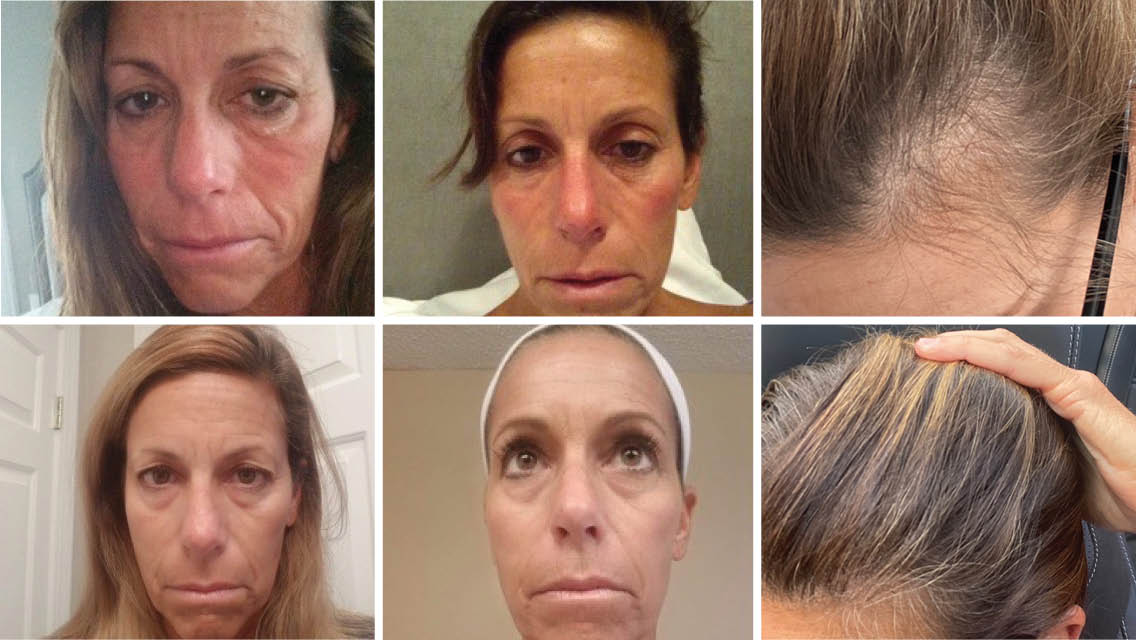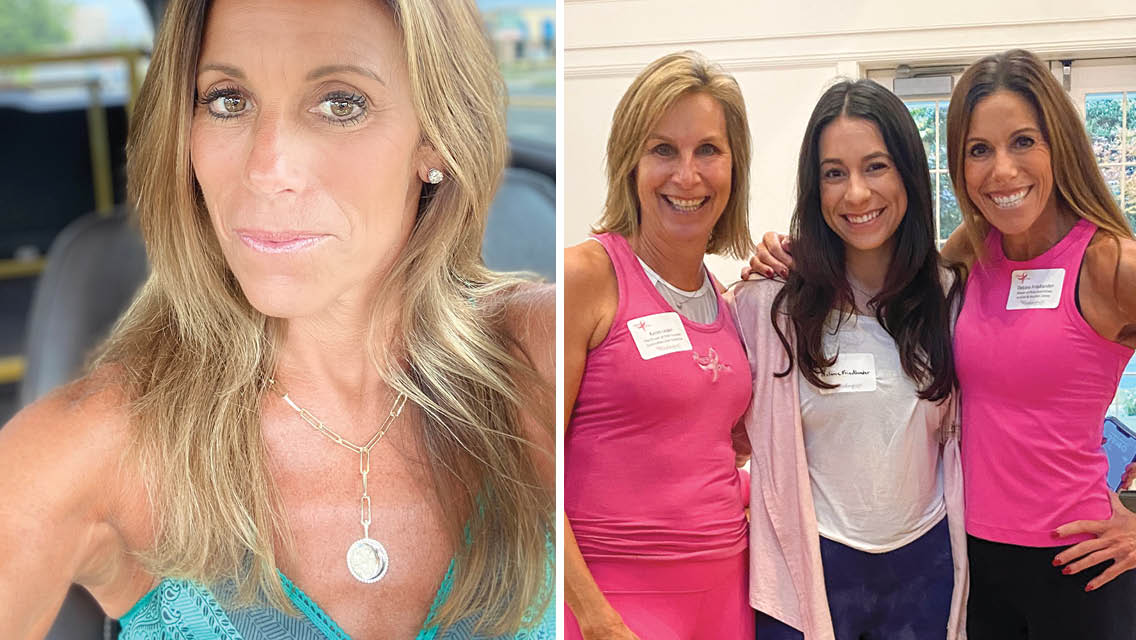I was only 31 in 1998 when I had a bilateral prophylactic mastectomy (also called a preventive mastectomy) after learning I had inherited the BRCA1 gene mutation. My mother had breast cancer when she was 29, then died from ovarian cancer at age 53. My grandmother also had breast cancer. A mastectomy would drastically reduce my risk of developing the disease. I had two young children and a husband. I wanted to live.
But two decades later, I was hardly living because of numerous inexplicable symptoms: hair loss; inflammation in my head, neck, spine, and back; anxiety; muscle weakness; fatigue. My brain fog was so bad that I’d get lost driving and miss doctors appointments; I could barely get myself out of the house.
Every day was a gamble: I never knew whether I would wake up feeling good — or like a truck had hit me.
Something was wreaking havoc on my body, and my doctors weren’t able to figure out what.
Hard Reality, Easy Decision
Back in 1998, having a preventive mastectomy was not only considered drastic, but it was practically unheard of. Yet I felt this ticking time bomb inside of me that I needed to defuse.
Christina Applegate would make the same choice in 2008 after finding a cancerous tumor in one breast, as would Angelina Jolie in 2013 after testing positive for the BRCA1 gene mutation. But when I was faced with the decision, I didn’t know anyone who had undergone preventive surgery.
At the time, I was given the choice between saline or silicone implants. When I asked about not getting implants, my doctors said that it wouldn’t look good and that I would be unhappy with the results.
I found it odd that I was offered silicone implants at all — especially after the FDA had dramatically restricted their use in 1992 because of evidence linking implants to joint inflammation, chronic inflammatory disease, and cancer.
In the end, I chose saline implants because I was assured they were safe. I’d been diagnosed with rheumatoid arthritis in my 20s, and I didn’t want to do anything risky.
I recovered quickly from my surgeries. The initial mastectomy was performed and I received tissue expanders, or empty breast implants that are injected with air or liquid over a period of weeks to create a pocket for the implants. While healing, I utilized my master’s degree in deaf education to teach my kids the signs for “hug” and “I love you,” so I could protect my sensitive chest.
The second surgery (four months later) involved taking the expanders out and putting the saline implants in.
I felt empowered and proud to have taken such a big step to reduce my risk of developing cancer. I counseled others who were facing the same dilemma, and I shared my story with the belief that I had made the right decision for me.
Struggling With Symptoms

Less than a year after getting the saline implants, my arthritis started to flare up more often. I thought, Good thing I didn’t choose silicone or I would’ve thought this was from the implants. I didn’t know saline implants had a silicone shell or that women with saline implants were experiencing health issues too.
Despite the pain, I knew how to work around my aching joints. I was versatile and could switch up workouts or back off when I needed to.
After my third child was born, in 2001, I continued to be a busy and fit mom. I ate well and exercised daily — working out relieved my stress. It gave me energy.
Then, 10 years after my breast implant surgery, I saw that the edges of my implants were noticeable and that implant wrinkles had developed under the skin — an effect known as rippling. I’d also developed capsular contracture, the hardening of scar tissue around the implant. My doctor suggested replacing the saline implants with new silicone implants. I was told they were completely safe, looked more natural, and could last more than 20 years. I replaced the saline implants with silicone in early 2010.
While I was initially thrilled with the look of the silicone implants, my health soon started to deteriorate. My muscles became weaker and I felt tired all the time. There were days I could barely catch my breath while taking a walk.
I told my doctors about these symptoms and their answers ranged from “Well, you might be overdoing it” to “You know you aren’t in your 20s anymore.”
The following years brought new and increasing symptoms, including extreme fatigue, heightened anxiety, weakness, and dizziness. I could barely lift a gallon of milk. I started developing infections that came on suddenly and put me in the hospital for days. A few of them were serious and ended up causing sepsis.
I also began experiencing spinal pain. I remember telling my husband that there was something major going on inside of me.
I went from doctor to doctor looking for answers, but none had any. They misdiagnosed me with fibromyalgia, myofascial pain syndrome, joint hypermobility syndrome, Lyme disease, chronic fatigue syndrome, mold toxicity, mast cell activation syndrome, and connective tissue disorder.
In 2011, I experienced debilitating upper-extremity pain that required emergency spinal surgery. I thought I’d gotten through the worst of it, but I was very wrong. Once in a while, I would wake up feeling energized and have a great day, only to be right back where I started the next morning.
At the beginning of 2013, blood tests showed that my levels of mercury, cadmium, and arsenic were off the charts. Meanwhile, testosterone, progesterone, and estrogen were nonexistent in my body, even though I’d been undergoing hormone-replacement therapy since having my ovaries removed in 2008.
My vitamin and nutrient levels were low too, but my cholesterol was high. Everything was so out of whack that the lab called my physician, concerned that I had been poisoned.
Throughout all of this, I continued to do my own research and even changed my diet by cutting out gluten, sugar, dairy, soy, and corn. I definitely saw improvements at first, but eventually the inflammation returned.
I prayed every evening that I would wake up feeling better. All I wanted was to feel like myself again.
Breast Implant Illness
In 2017, I found a Facebook group for breast implant illness (BII), a condition I hadn’t considered. I had many friends who had implants and were perfectly fine, so I was doubtful that my symptoms were connected to my implants. Nonetheless, after joining the group — which is called Breast Implant Illness and Healing by Nicole — I read about thousands of women like me whose health had declined after getting implants.
For a long time, physicians doubted the existence of such a condition, which still isn’t recognized as an official medical diagnosis. Yet the medical community is investigating its possibility as more people have come forward to report symptoms that arose after getting breast implants and improve after removing them.
Although many women with implants don’t seem to experience these adverse reactions, it’s frustrating to see how long it’s taken experts to issue a black-box warning and create new guidelines to address these concerns.
Many of my symptoms overlapped with those of BII, but there was no way to test for the condition. I came to understand that I couldn’t know for sure unless I had them removed.
By 2019, I was in pain all of the time and had tried everything to get better. After watching the Facebook group grow rapidly in just a few years, I started to seriously consider whether my implants could be at the root of my symptoms.
On December 13, 2019, I took a leap of faith and had my implants removed by en bloc capsulectomy. This means that the entire implant and the surrounding scar tissue are removed in one piece. I opted to “go flat” and forgo any reconstruction.
The first thing I noticed after the procedure was that I could take a deep breath again. My pain was gone, and my eyes and face were no longer red and swollen. I had energy for the first time in years, and I felt hopeful.
Gratitude in Healing
It’s been over three years since I had my implants removed, and although I’m still recovering, there’s no doubt that I’m much better. When I compare how I feel today with how I felt prior to the removal, it’s like night and day. My brain fog is gone; the panic attacks are gone; my hair has grown back. The improvement is undeniable.
I encourage all women who are considering implants to educate themselves about the risks. For example, implants contain numerous chemicals as well as heavy metals, including platinum, arsenic, and zinc. As of 2023, implants have also been linked with cancers such as anaplastic large cell lymphoma and breast implant–associated squamous cell carcinoma. The FDA now requires doctors to warn patients about the risks involved with breast implants.
Additionally, it’s important to know that these are not lifetime devices. The current guidance is that most implants should be exchanged every 10 to 15 years. So, a 25-year-old woman getting breast augmentation could need up to five more surgeries if she lives to be 80.
Living with illness has taught me to cherish the great days and do whatever I can to make tomorrow even better. I’m grateful for all the progress I have made in my recovery, which has involved seeing a therapist to process my emotional trauma, working with a functional neurologist to repair the damage to my brain, and collaborating with an osteopath to heal my gut.
I turned 56 this year and celebrated my 31st wedding anniversary with my husband, Gary. I’ve watched my three children become amazing adults. I know I made the right decision back in 1998 to have a preventive mastectomy, because it saved my life. In 2008, my older sister was diagnosed with breast cancer at age 40 and died a year later.
Now, 25 years after my initial surgery, I feel empowered again to reclaim my health. I’ve slowly worked my way up to exercising six days a week with strength training and barre classes, pickleball, and cardio.
No longer do I see a sickly person staring back at me when I look in the mirror. In her place, I see a brave woman, a warrior who took matters into her own hands. A woman who learned to love herself from the inside out.
(For additional resources and support, please visit Healing Breast Implant Illness.)
Debbie’s Top 3 Tips for Success
- Stay positive and remember you are not alone. “Trust your instincts if your health is suffering,” Debbie says. “Find someone to talk to who can validate your concerns.”
- Do your research. “If you are considering a preventive mastectomy, find a doctor who is familiar with the latest data about the risks of implants,” she advises. “Your surgeon should give you the option to go flat, if you choose, or to use autologous tissue to create new breast tissue.”
- Honor your scars. “They are reminders of how brave you are and how powerful your body is. Cherish them.”
My Turnaround
For more real-life success stories of people who have embraced healthy behaviors and changed their lives, visit our My Turnaround department.
Tell Us Your Story! Have a transformational healthy-living tale of your own? Share it with us!





This Post Has 0 Comments